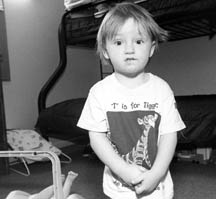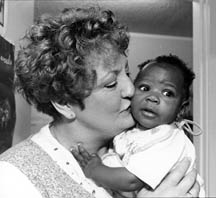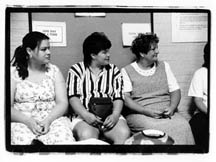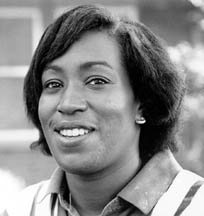|
First
choice, last chance
A residential
drug treatment center for women in Fort Worth gets an injection of help
from TCU's 35-year-old Institute of Behavioral Research.
By
Nancy Bartosek

 |
| First
Choice is a long-term (up to one-year) residential program for women
with children established in 1990 and run by the Salvation Army. The
women live with their children (such as Eugene, below) in independent
apartments on the grounds and participate in private and group therapy
and drug and alcohol recovery, as well as in life skills assistance
such as budgeting and nutrition and parenting training. The center
collaborates with numerous social service agencies to help these women
get healthy and back into the mainstream of society. |
Researcher
Danica Knight's new office in the old Colonial Cafeteria on Berry Street
is tidy and inviting; her two young children grin from picture frames
on the desk.
Knight '90
MA (PhD '91), who has been studying ways to improve drug abuse treatment
at TCU's Institute of Behavioral Research since 1992, says she has the
best of both worlds; she works part-time and mothers full-time.
But ask her
about First Choice, a residential drug treatment center for women that
she has been studying, and you'd think she had nothing else in her life -- facts
and statistics and research results pour out unencumbered.
For Knight,
it's more than a bunch of numbers with words wrapped around them. She
knows the numbers have names like Sami and Rhye, Yvette and Bryan. She's
been there, talked to the women, heard about the abuse, and the pain.
And the shame.
That's why
Knight collects and studies and pours over those numbers. To help women
like Sami write new, happy endings.
I remember
the exact day, the exact hour I came here. I'd just detoxed from heroine
and cocaine. I'd smoked pot every day for 23 years. I drank on a regular
basis and used heroine and coke mixed for the past five years. I'd always
managed. I held down a good job, I stayed clear of the law, I took care
of my son. But by age 40 I had a $700 a day habit and had been arrested
four times in six months for doing what it takes to get my drugs. At the
end, my mother came to say she was going to take my son. I weighed 100
pounds. I got into detox where they told me about First Choice. I came
up every day for three weeks begging them to let me in, crying, ‘I'm going
to die if you don't get me in here.' On Oct. 9, a spot opened up. Rhye
and I stayed seven and a half months.
 Sami
shifted in her seat and looked up with clear eyes and a gentle smile.
She is no longer ashamed to tell her story. She's heard worse. She knows
now that her addiction is a disease, not a character flaw. And that with
help, it can be beaten. Sami
shifted in her seat and looked up with clear eyes and a gentle smile.
She is no longer ashamed to tell her story. She's heard worse. She knows
now that her addiction is a disease, not a character flaw. And that with
help, it can be beaten.
She's "three
years, eight months and four days clean -- not that I'm counting."
Sami's office
at First Choice is a cheery place with colorful posters and pictures of
her son Rhye, now 14. After leaving First Choice in 1997, Sami trained
to be a chemical dependency counselor and then returned to help. She
now counsels and coordinates aftercare for the center's residents.
In 1995,
First Choice Director Paula E. Hood heard about a counseling manual produced
by TCU's Institute of Behavioral Research. An internationally recognized
research center, IBR has been evaluating the effectiveness of drug abuse
treatment programs since 1968.
When approached
by Hood, IBR Director D. Dwayne Simpson and Deputy Director Lois Chatham
suggested they had more to offer than a manual. Thus began a five-year
collaboration that has produced a body of research, major funding for
both institutions, additional training modules and an expanded, more effective
program at First Choice.
 "This
kind of evaluation can be time consuming and burdensome," Hood admitted.
"I sought out the research because we needed the grant money the
[federal] Center for Substance Abuse Treatment was offering. But it turned
out that the research itself was as important to the development of the
program as the money was." "This
kind of evaluation can be time consuming and burdensome," Hood admitted.
"I sought out the research because we needed the grant money the
[federal] Center for Substance Abuse Treatment was offering. But it turned
out that the research itself was as important to the development of the
program as the money was."
It was a
lot of money -- the five-year grant totaled more than $4 million. It
allowed First Choice to double their occupancy from 10 to 20 apartments
and offer expanded services.
But with
that grant came the requirement that First Choice staffers gather what
initially felt like a tidal wave of information. Intake interviews now
took several hours. Complicated forms requiring specialized completion
procedures were introduced, then adapted and reintroduced. Already heavy
work loads became heavier.
Hood, who
now has a private counseling practice, would later say it only worked
because the IBR staff was patient and persistent during the training process,
often spending many one-on-one hours helping ease the transition. A few
months later the bulky evaluation process was smoothly integrated.
 I
started using drugs at age 30. One night I found some crack cocaine in
the bathroom and was really angry because my boyfriend, a professional
boxer, and I had been going to schools and churches and talking to kids
about not using drugs, and here he was using drugs and I didn't know it.
I flushed it down the toilet. Well, his first reaction was to hit me.
It was a real bad experience. He beat me up that night and kept telling
me to use. I wouldn't. All night this went on until he wrapped a telephone
cord around my throat. I thought I was going to die. I finally gave in.
I eventually got away from him, but not the addiction. A few years later,
I told my mom that I should have just let him kill me that night because
either way, I was dead. That's how I felt because of the drugs. I
started using drugs at age 30. One night I found some crack cocaine in
the bathroom and was really angry because my boyfriend, a professional
boxer, and I had been going to schools and churches and talking to kids
about not using drugs, and here he was using drugs and I didn't know it.
I flushed it down the toilet. Well, his first reaction was to hit me.
It was a real bad experience. He beat me up that night and kept telling
me to use. I wouldn't. All night this went on until he wrapped a telephone
cord around my throat. I thought I was going to die. I finally gave in.
I eventually got away from him, but not the addiction. A few years later,
I told my mom that I should have just let him kill me that night because
either way, I was dead. That's how I felt because of the drugs.
Yvette's
enthusiasm for First Choice spills out in rapid-fire words. She and 5-month-old
Bryan have been there since February, a month after Bryan was born with
crack in his system. She's clean and clear now, finally, and plans to
stay several more months to work on the internal problems that landed
her in this predicament.
Research
has shown that most drug abusers have a wide spectrum of psychosocial,
emotional and physical problems which must be treated in conjunction with
the substance abuse. This makes rehabilitation a complex task.
When the
first bits of data began to flow in, it was apparent that some of the
women's and children's needs were not being met. That information did
not come as a surprise.
First Choice
staffers had long recognized their services had gaps, but without empirical
data, deciding what was needed, by whom, and when, was based on conjecture
or anecdotal information.
"For
example, " Hood said, "We knew there were physical and sexual
abuse issues, but the research showed 90 percent had been abused -- an
even greater number than we suspected. So we added more services in that
area." The numbers have been useful in some unexpected ways. Barbara
Brown, First Choice director since January, said they often must act as
advocates to the court or other agencies and having hard facts to back
them up makes a big difference. Sometimes they even have to keep law enforcement
agencies from incarcerating the women.
"We
can go to court and say, ‘You can't do this, research shows they need
to stay right here,' " she said. "These women have bottomed
out when they come here, and we need to do everything we can to keep them
in a safe and nurturing environment until they are ready."
Sami didn't
know about Knight's numbers when she arrived at the First Choice doorstep,
but they sure impacted her life: She was housed in one of the 10 apartments
added in the expansion.
And when
Yvette talks through her abuse, she doesn't know that her counselor is
using a manual and knowledge Knight and her colleagues developed from
the IBR studies. She just knows it helps. She just knows she feels safe
now, and filled with hope.
"Our
program was good before," Hood said. "But this collaboration
with IBR did so much. They raised our level of professionalism, allowed
us to expand services and meet needs better, they even helped us as therapists
on how to work best with people -- and that was just on the peripheral.
"IBR
has been there for 35 years. They know what they're doing. We were very
fortunate to have IBR."

Top
|



